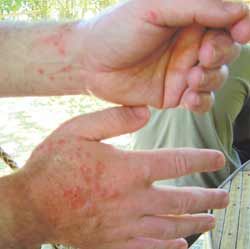- Clinical Technology
- Adult Immunization
- Hepatology
- Pediatric Immunization
- Screening
- Psychiatry
- Allergy
- Women's Health
- Cardiology
- Pediatrics
- Dermatology
- Endocrinology
- Pain Management
- Gastroenterology
- Infectious Disease
- Obesity Medicine
- Rheumatology
- Nephrology
- Neurology
- Pulmonology
Jellyfish Sting
While scuba diving in the Philippines, a healthy 36-year-old man noticed a red rash on his wrists and dorsa of both hands after he surfaced from a dive. Within a couple of hours, the rash had become painful, swollen, itchy, and papular.
While scuba diving in the Philippines, a healthy 36-year-old man noticed a red rash on his wrists and dorsa of both hands after he surfaced from a dive. Within a couple of hours, the rash had become painful, swollen, itchy, and papular.
The lesions were localized to the man's hands and wrists. The differential diagnosis included swimmer's itch, contact with coral, seabather's eruption, and jellyfish sting. The man reported that he had brushed against multiple small white jellyfish, which suggested that he most likely had been stung.
Jellyfish tentacles contain nematocysts that fire on tactile stimulation. The sting causes immediate burning, numbness, inflammation, and paresthesia. Linear papules or wheals develop where the tentacles come in contact with the skin. Systemic toxic reactions can occur in persons with severe or widespread stings or in those with a history of severe allergic reactions. Movement of the envenomed part, such as a limb, leads to mobilization of the venom from the inoculation site. Fatalities from jellyfish stings, while rare, can occur; box jellyfish, prominent in the Indo-Pacific region, are considered the most lethal.

Treatments include immobilization of the envenomed part and deactivation of the nematocysts (with rubbing alcohol, hot sea water, vinegar, meat tenderizer, or urine). Washing with fresh water or towel drying causes the nematocysts to fire and should be avoided. Tentacles can be removed with a sharp edge, such as the side of a credit card. Moist beach sand can soothe the area. Application of a corticosteroid cream and cool compresses can help suppress the inflammation.
Swimmer's itch (or schistosomal dermatitis) predominantly occurs in freshwater. The itching, which results after the cercariae penetrate the skin, can last about an hour and is followed by the development of discrete, pruritic papules. The rash usually subsides within a week and is treated symptomatically with antihistamines, calamine lotion, corticosteroid creams, and cool compresses. Preventive measures include towel drying immediately after leaving the water, because most cercariae enter the skin while the water is evaporating.
Contact withcoral most often causes minor skin lacerations. Some types of coral are more toxic, and contact may cause pruritic red wheals (coral poisoning). Minor wounds typically heal slowly, are painful, and can easily become infected, particularly if limestone particles become lodged in the skin or wound. Retained coral may cause a delayed foreign-body reaction. Therapy includes thorough cleansing of the wound to remove all debris and application of hydrogen peroxide.
Seabather's eruption occurs when jellyfish are close to shore and their nematocysts become trapped under bathing suits. The rash, which consists of pruritic papules or wheals that resemble insect bites, develops after prolonged wearing of contaminated suits or showering with freshwater. The lesions can cover wide areas and usually last several days, although they may persist up to 6 weeks in severe cases. Treatment is the same as that for swimmer's itch.
